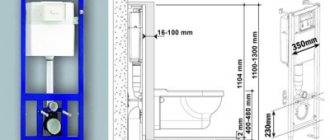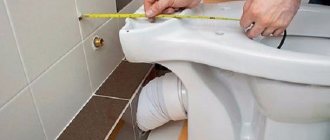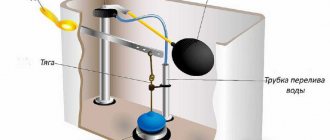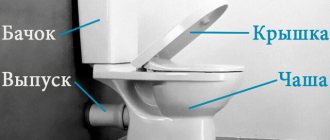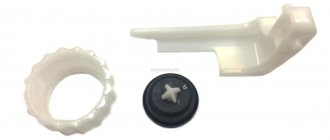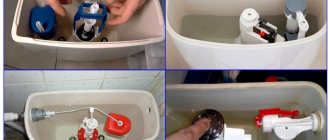Without a doubt, the toilet plays a key role when planning a bathroom. The correct choice of sanitary ware helps not only to save interior space, but also provides comfort when performing hygiene procedures. On the modern market of plumbing equipment you can find toilets of various shapes, sizes and installation methods.
We have previously discussed the types and sizes of bathtubs here, the types and sizes of vanities here, the key features of shower enclosures, and the shape and sizes of bathroom tiles in this article.
Device and classification
Shape of the outlet pipe of the drainage system
The following types of pipes are distinguished:
- Oblique (angular) or “outlet into the wall”
- Straight or horizontal
- Vertical or “floor outlet”
Type (shape) of the bowl
The standard is considered to be plumbing fixtures with a funnel-shaped, visor-shaped and dish-shaped bowl (see figure). The plate version can be considered obsolete despite its infrequent, but still presence in construction stores.
Funnel-shaped and visor have their own pros and cons. One form is good for everyone, but it splashes a lot, the other has almost no splashes, but more often a brush is required and the noise level is higher when draining water.
Flush cistern
Sanitaryware is also divided according to the installation method. Classics of the genre are floor-mounted and wall-hung toilets, which can be found in both corner and wall-mounted versions. It’s quite easy to get confused in such a variety, so let’s look at the standard sizes that you can use when choosing plumbing fixtures.
Do you know?
That the word “toilet” appeared quite recently. The Spanish company Unitas launched mass production of plumbing products made of earthenware 1909 Later, the word toilet began to be used to refer to any sanitary and technical device, regardless of the manufacturer.
Rules for choosing toilet dimensions
Standard dimensions of wall-hung sanitary ware
The main criterion when choosing a toilet is the total area of the sanitary unit, as well as the dimensions of adjacent elements. If this is a combined room, then you should focus on the placement of a bath or shower stall, as well as auxiliary equipment and accessories. The most practical way is to draw up a drawing showing the exact dimensions of the toilet with a cistern, following the advice of professionals. When choosing dimensions, it is important to follow the following rules:
- The toilet must be located at least 30 cm from the rear or side wall of the room. Otherwise, cleaning in this area will be significantly difficult, causing the accumulation of bacteria and dirt.
- The main role in the ease of use of plumbing equipment is played by its length, width and height, which are selected individually.
- The distance between the equipment and other objects should be at least 35 cm, and in a combined bathroom - at least 60 cm. If in the second case the toilet is located near the bathroom, you can install a small partition 15-30 mm thick. When installing a shower stall, it is important to take into account the amplitude and side of the door opening so that it does not pass too close and does not touch other devices.
- In a cramped room, it is more profitable to install a small corner toilet, saving space. An installation with a cistern built into the wall is also very practical.
If finances allow, you can contact a professional designer who will independently measure the room and create a project plan with an ergonomic arrangement of all elements. However, such a service can be quite expensive, so you can do it yourself without involving specialists.
Choose your size
Standard dimensions of a floor-standing toilet
If we talk about standard toilet sizes, domestic manufacturers try to adhere to the following sizes:
| Product type | Length, cm | Height, cm | Width, cm |
| Floor-standing toilet with a solid cast shelf (for securing the cistern) | 60,5 | 34 | 32 — 37 |
| Toilet without a solid cast shelf | 33-46 | 36 | 30 — 35 |
It is important to understand that these are “bare” dimensions, without additional accessories. Considering that in most cases, the toilet comes complete with a tank, the overall dimensions increase proportionally.
It is worth noting that the height of the tank may vary depending on the country of origin. For example, the accepted European standards are considered to be dimensions 680*360*400 for the depth (length), width and height of the toilet rim, respectively.
Hanging
| Product type | Length, cm | Height, cm | Width, cm |
| Wall-hung toilets (consisting of a bowl only) | 48 — 70 | 35 — 40 | 35 — 37 |
Recently, such models of plumbing fixtures are gaining steadily growing popularity. The advantage of wall-hung toilets is that the water supply is hidden in the wall, so the design of the bathroom is not disturbed. In addition, the hinged structure visually expands the internal space. It is worth noting that such models are very resistant to static loads and can withstand up to 400 kg . Some manufacturers provide a double safety margin ( up to 800 kg ).
It is worth noting that installing a wall-hung toilet greatly simplifies cleaning the premises.
Wall-hung plumbing comes complete with an installation - a special mounting structure, the dimensions of which are indicated in the article below.
Corner
Such models are often installed in small residential buildings and industrial buildings. Thanks to the corner installation, the toilet not only saves internal space, but also partially hides utility lines. The following standard sizes are relevant for such models:
- Height: 37 – 43 cm
- Depth: 72.5 – 79 cm
- Width: 34.5 – 37.5 cm
When choosing a size, you must take into account the width of the corner.
Built-in
Such models are characterized by a hidden installation of the cistern. This element is hidden by a false panel or built into the wall. Thanks to the installation features, built-in toilets operate virtually silently.
When choosing plumbing, you can be guided by the following parameters:
- Height: 39 – 42 cm
- Depth: 47 – 58 cm
- Width: 35.5 – 37 cm
It is worth noting that built-in toilets are found on the market in floor-mounted and wall-hung versions.
Installation - specialized mounting structure
- Frame . Depth: 135 - 300, height - 800 - 1,400, width - 500 - 600 mm.
- Block . Depth: 100 - 150, height - up to 1,000, width - 500 - 600 mm.
Toilet - bidet: two in one
Plumbing fixtures that combine the functions of a toilet and a bidet are almost impossible to find in standard apartments: they are a rare guest on the domestic market. However, such models are very convenient to use, therefore they are widely used in cottages and apartments built according to individual projects. Typically, shower toilets differ from standard products in their larger dimensions and increased volume of the flush cistern.
The general dimensions of such products can be as follows:
- Floor installation : 700/410/785 (length/width/height). Along the toilet rim – 390 mm .
- Hanging (hidden installation): 485/355/315 (length/width/height).
Most shower toilet models have water pressure regulators and thermostats.
Big sizes
Such products are intended for people with excess body weight. Large toilets differ from standard models and can be made to order. The following parameters are considered standard dimensions:
- Height – 65 cm
- Depth – 70 cm
- Width – 40 cm
The design of such toilets is usually reinforced, so they can withstand loads of up to 500 kg .
The most compact
If we talk about non-standard sizes, it makes sense to consider the parameters of small-sized products. Narrow, small toilets are ideal for installation in small bathrooms. Here you can use the following dimensions:
- Width – from 33 cm
- Depth – from 59 cm
- Height – from 47 cm (with tank)
Among small-sized plumbing fixtures, toilet bowls with a size of 35*63*77 cm , but here it all depends on the installation location and personal preferences. Thanks to their compact dimensions, such toilets look natural even in small toilets.
Children's toilet sizes
If the size of the bathroom allows, you can install an additional mini toilet for children. Usually these are compact models that do not take up much space. When choosing children's plumbing, you can be guided by the following dimensions:
| Product type | Length, cm | Height, cm | Width, cm |
| Special products for use by small children | 28-40,5 | 13-33,5 | 21-29 |
The height of the toilet is chosen so that a person’s feet are confidently on the floor. This is the only way to achieve the most comfortable position. A special stand can be used for children:
After choosing and purchasing the optimal size toilet, the process is just beginning. Below we provide related information that will be useful to you.
Features of measurements
To ensure that the purchased plumbing fixtures can be installed without problems, it is recommended to consider the following factors:
- If there is a sewer system laid near the walls (standard option), and not in the ceilings between floors, you should buy options with an oblique pipe. Their installation is quite simple, regardless of the location of the sewer outlet;
- based on the width and length of the sewer outlet pipe, it is necessary to select a connecting collar;
- presence of a bidet;
- The flexible hose that connects the water supply and the drain tank must be short, but not hanging in the air, otherwise the water will stagnate.
When purchasing a toilet, you should take into account not only the dimensions and area of the bathroom or shower room, but also the shape and width/height of the sewer outlet. The distance from the wall to the toilet directly depends on the pipe.
It is believed that the presence of a lower type pipe requires the most effort for re-installation. In this case, reconstruction will be necessary, which will affect the flooring and wall decoration.
Therefore, before purchasing plumbing fixtures, it is important to focus on how much space the installed toilet will take up (for example, know the height of the toilet from the floor).
How to choose a lid and toilet seat
To choose a suitable toilet seat, you need to know exactly the dimensions of the plumbing fixtures. It is believed that the lid should exceed the dimensions of the toilet by about 0.5 centimeters , however, this is not a necessary condition. To make accurate measurements, you need to find out three main parameters:
- Distance between mounting holes.
- The length from the fastening axis to the end of the cover.
- Distance from the mounting axis to the outer rim of the toilet.
In addition, you need to take into account an important nuance: the shape of the lid must match the rim of the toilet.
Seat - pad with handrails
Convenient modifications of lids with handles are provided for disabled people:
What is this mysterious microlift?
For ease of use of plumbing fixtures, additional accessories are sometimes included in the design of the toilet. One of these elements is a microlift. According to technical parameters, a microlift is similar to a regular door closer and performs similar functions. The task of the microlift is to ensure smooth lowering of the lid onto the toilet rim, excluding sharp impacts that can damage the toilet seat and ceramics.
Toilets with a microlift can be found in any plumbing store; the installation of this element has virtually no effect on the cost of the product.
Types of installation systems
There may be many minor differences, but the main thing is what the installation should be attached to. On this basis, such structures are divided into two types:
Block
Such structures are hung on a wall, which, of course, must be permanent. If you fix such an installation on a thin partition, it will immediately collapse under the user’s weight.
Block installation
Frame
Installations of this type are also called free-standing. They are not attached to the wall and transfer the entire load to the floor, so they have reinforced legs. Thus, such a structure can be installed even near a plasterboard partition.
This will be required during installation. Corrugation and cuff
When installing a toilet, corrugations and cuffs are used in accordance with the shape of the outlet pipe of the drainage system. Generally accepted standards apply here and should be taken into account during installation.
- Corrugation . Used to drain into the public sewer system. The length of the corrugation is usually 200-1,200 mm , diameter: 130 mm connection to the toilet, 110 mm connection to the sewer.
- Cuff . The element is designed for a sealed joint between corrugation and plumbing. The length of such products varies between 112-130 mm , the diameter is selected in accordance with the mounting location.
Approximate weight depending on material of manufacture
The weight of a plumbing structure directly depends on the materials from which it is made. The body itself, the drain mechanism - all this matters. As a rule, plumbing fixtures are made from sanitary porcelain and sanitary ware. Earthenware is heavier than porcelain, so a toilet made from it will weigh about 26-31.5 kg .
Porcelain will be somewhat lighter: 24.5-29 kg. In addition, there are samples made of marble, plastic and stainless steel. Marble ones are the heaviest. They will weigh between 100 and 150 kg . Stainless steel structures are lightweight and durable. Their weight is from 12 to 19 kg. Moreover, they are not susceptible to cracks and chips. It is good to install such devices in non-residential premises with high traffic volumes.
The lightest toilet is, of course, a plastic one . A product of any parameters, made of plastic, will weigh no more than 10.5 kg. But the weight of a plumbing fixture is affected not only by the material from which it is made.
Often, when choosing the lightest toilet, the buyer does not take into account the weight of the tank. But the total weight of the structure also depends on its volume and the material from which the drain mechanism is made. A standard six-liter tank weighs about 11 kg . Accordingly, with a smaller volume, the total weight of the product will also decrease.
Hanging models will weigh less than floor-standing ones, due to the fact that less material was spent on their production: after all, they do not have legs. So, the weight of the toilet can vary from 5 to 150 kg .
Installation diagram
Fastening suspended plumbing fixtures is a reason for a separate detailed article. With floor-standing models everything is much simpler. Toilet bowls are placed on special glue (for example, “heavy duty” in yellow tubes) or attached to bolts with holes drilled in the floor. This process is shown schematically below.
To make sanitaryware comfortable to use, the distance to the toilet door must be at least 60 centimeters , the recommended space to the walls is 35 cm .
Distances
It’s good for those who have a large room allocated for a bathroom or toilet. If yours is not so large, you need to know the minimum tolerances for the distance from the toilet to nearby “structures” and devices.
Distance from the toilet to the wall: according to standards - at least 25 cm
- There should be at least 25 cm between the bidet and the toilet.
- There must be at least 60 cm of free space in front. That is, the distance from the edge of the bowl to the door or wall in front is 60 cm or more.
- There should be at least 25 cm of free space on the sides. This is not enough, but tolerable. Comfortable distance - 35 cm.
Now you draw a plan of your bathroom, mark the minimum distances and see what size toilet will fit into your toilet. So it's simple.
How to supply water to the tank
A tank is a container that holds water for flushing. Without supplying water pipes to this device, the toilet simply will not be able to perform its main functions - flushing animal products.
Usually, water is supplied to it either from the side or from below. The most common method is the approach from the right or left, that is, the lateral method.
The lower supply is less common, since in this case it is more difficult to attach. But when supplying from below, you cannot hear water entering the tank, which cannot be said about the first method.

